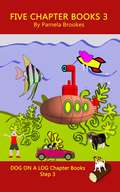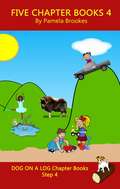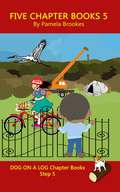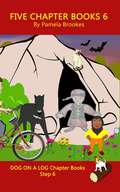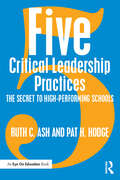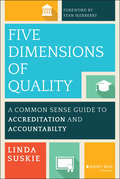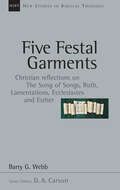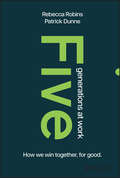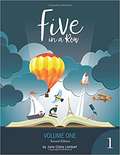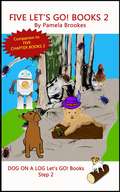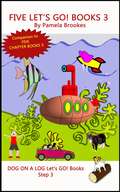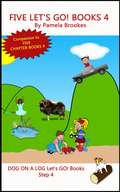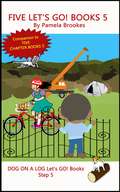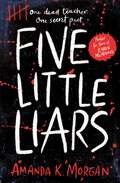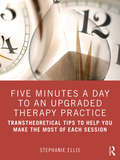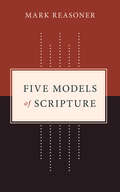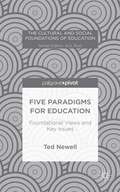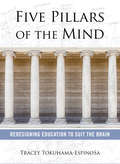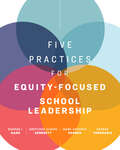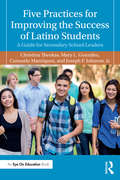- Table View
- List View
Five Chapter Books 3: Decodable Books for Phonics Readers and Dyslexia/Dyslexic Learners (DOG ON A LOG Book Collections #Volume 3)
by Pamela BrookesDecodable Chapter Books for Phonics Readers and folks with a Dyslexic Learning Style <P><P>This collection is the five books in Step 3 of the DOG ON A LOG Chapter book series. <P><P>The books are: <P><P>Mr. Bing Has Hen Dots</br> The Junk Lot Cat</br> Bonk Punk Hot Rod</br> The Ship With Wings</br> The Sub In The Fish Tank <P><P>Individual books can also be purchased separately. <P><P>Sight Words: </br> a, are, as, be, could, do, does, for, from, go, goes, has, have, he, her, here, his, I, into, is, like, likes, me, Mr., Mrs., my, no, of, OK, or, put, puts, said, say, says, see, sees, she, should, the, their, there, they, to, want, wants, was, we, what, where, would, you, your <P><P>Each book has about 960 to 1,170 total words <P><P>These are Step 3 Chapter books. <P><P>The DOG ON A LOG Books series are for phonics readers and folks with a dyslexic learning style. The words used reflect the inclusion of 1 to 3 new phonics rules in each step. There are five books at each step. <P><P>The chapter books are written in a chapter format with one picture in most chapters. They are longer, have more detail, and sometimes offer more complexity than the Let’s GO! Books. They’re great for practicing known and new phonics rules. They’re also just fun reading. <P><P>DOG ON A LOG Let’s GO! Books are shorter versions of DOG ON A LOG Chapter books. Let’s GO! books tell the same stories with about 8 pictures and only a few sentences per page. They’re perfect as an introduction to the new phonics rules or simply for fun reading for younger kids. <P><P>DOG ON A LOG Phonics Progression <P><P>Step 1: Consonants, primary sounds Short vowels Digraphs: ch, sh, th, wh, ck 2 and 3 sound words Possessive ‘s <P><P>Step 2: Bonus letters (f, l, s, z after short vowel) “all” –s suffix <P><P>Step 3: ang, ing, ong, ung, ank, ink, onk, unk <P><P>Step 4: Consonant Blends to make 4 sound words 3 and 4 sound words ending in –lk, -sk <P><P>Step 5: Digraph blends –nch to make 3 and 4 sound words Silent e, including "-ke" <P><P>Step 6: ild, old, olt, ind, ost <P><P>Step 7: 5 sounds in a closed syllable word plus suffix -s (crunch, slumps) 3 letter blends and up to 6 sounds in a closed syllable word (script, spring) <P><P>Step 8: Two syllable words with 2 closed syllables, not blends (sunset, chicken, unfit) <P><P>WATCH FOR MORE STEPS AND BOOKS COMING SOON <P><P>For information on upcoming books see dogonalogbooks.com or visit our Facebook page.
Five Chapter Books 4: Decodable Books for Phonics Readers and Dyslexia/Dyslexic Learners (DOG ON A LOG Book Collections #Volume 4)
by Pamela Brookes<P><P>Decodable Chapter Books for Phonics Readers and folks with a Dyslexic Learning Style. <P><P>This collection is the five books in Step 4 of the DOG ON A LOG Chapter book series. <P><P>The books are: <P><P>The Push Truck</br> The Sand Hill</br> Lil Tilt And Mr. Ling</br> Musk Ox In The Tub</br> Trip To The Pond <P><P>Individual books can also be purchased separately. <P><P>Sight Words: </br> a, are, as, be, could, do, does, for, from, go, goes, has, have, he, her, here, his, I, into, is, like, likes, me, Mr., my, of, OK, or, push puts, said, saw. say, says, see, sees, she, should, the, there, they, to, want, wants, was, we, what, where, would, you, your <P><P>Each book has about 700 to 1,130 total words <P><P>These are Step 4 Chapter books. <P><P>The DOG ON A LOG Books series are for phonics readers and folks with a dyslexic learning style. The words used reflect the inclusion of 1 to 3 new phonics rules in each step. There are five books at each step. <P><P>The chapter books are written in a chapter format with one picture in most chapters. They are longer, have more detail, and sometimes offer more complexity than the Let’s GO! Books. They’re great for practicing known and new phonics rules. They’re also just fun reading. <P><P>DOG ON A LOG Let’s GO! Books are shorter versions of DOG ON A LOG Chapter books. Let’s GO! books tell the same stories with about 8 pictures and only a few sentences per page. They’re perfect as an introduction to the new phonics rules or simply for fun reading for younger kids. <P><P>DOG ON A LOG Phonics Progression <P><P>Step 1: Consonants, primary sounds Short vowels Digraphs: ch, sh, th, wh, ck 2 and 3 sound words Possessive ‘s <P><P>Step 2: Bonus letters (f, l, s, z after short vowel) “all” –s suffix <P><P>Step 3: ang, ing, ong, ung, ank, ink, onk, unk <P><P>Step 4: Consonant Blends to make 4 sound words 3 and 4 sound words ending in –lk, -sk <P><P>Step 5: Digraph blends –nch to make 3 and 4 sound words Silent e, including "-ke" <P><P>Step 6: ild, old, olt, ind, ost <P><P>Step 7: 5 sounds in a closed syllable word plus suffix -s (crunch, slumps) 3 letter blends and up to 6 sounds in a closed syllable word (script, spring) <P><P>Step 8: Two syllable words with 2 closed syllables, not blends (sunset, chicken, unfit) <P><P>WATCH FOR MORE STEPS AND BOOKS COMING SOON <P><P>For information on upcoming books see dogonalogbooks.com or visit our Facebook page.
Five Chapter Books 5: Decodable Books for Phonics Readers and Dyslexia/Dyslexic Learners (DOG ON A LOG Chapter Book Collections #Volume 5)
by Pamela BrookesDecodable Chapter Books for Phonics Readers and folks with a Dyslexic Learning Style. <P><P>This collection is the five books in Step 5 of the DOG ON A LOG Chapter book series. <P><P>The books are: <P><P>Bake A Cake</br> The Crane At The Cave</br> Ride A Bike</br> Crane Or Crane?</br> The Swing Gate <P><P>Individual books can also be purchased separately. <P><P>Sight Words: </br> a, are, as, be, come, comes, could, do, does, egg, eggs, for, from, go, goes, has, have, he, her, here, his, I, into, is, me, my, of, OK, or, pull, pulls, put, puts, said, say, says, see, sees, she, should, talk, the, their, there, they, to, walk, walks, want, wants, was, we, what, where, would, you, your <P><P>Each book has about 1,000 to 1,190 total words <P><P>These are Step 5 Chapter books. <P><P>The DOG ON A LOG Books series are for phonics readers and folks with a dyslexic learning style. The words used reflect the inclusion of 1 to 3 new phonics rules in each step. There are five books at each step. <P><P>The chapter books are written in a chapter format with one picture in most chapters. They are longer, have more detail, and sometimes offer more complexity than the Let’s GO! Books. They’re great for practicing known and new phonics rules. They’re also just fun reading. <P><P>DOG ON A LOG Let’s GO! Books are shorter versions of DOG ON A LOG Chapter books. Let’s GO! books tell the same stories with about 8 pictures and only a few sentences per page. They’re perfect as an introduction to the new phonics rules or simply for fun reading for younger kids. <P><P>DOG ON A LOG Phonics Progression <P><P>Step 1: Consonants, primary sounds Short vowels Digraphs: ch, sh, th, wh, ck 2 and 3 sound words Possessive ‘s <P><P>Step 2: Bonus letters (f, l, s, z after short vowel) “all” –s suffix <P><P>Step 3: ang, ing, ong, ung, ank, ink, onk, unk <P><P>Step 4: Consonant Blends to make 4 sound words 3 and 4 sound words ending in –lk, -sk <P><P>Step 5: Digraph blends –nch to make 3 and 4 sound words Silent e, including "-ke" <P><P>Step 6: ild, old, olt, ind, ost <P><P>Step 7: 5 sounds in a closed syllable word plus suffix -s (crunch, slumps) 3 letter blends and up to 6 sounds in a closed syllable word (script, spring) <P><P>Step 8: Two syllable words with 2 closed syllables, not blends (sunset, chicken, unfit) <P><P>WATCH FOR MORE STEPS AND BOOKS COMING SOON <P><P>For information on upcoming books see dogonalogbooks.com or visit our Facebook page.
Five Chapter Books 6: Decodable Books for Phonics Readers and Dyslexia/Dyslexic Learners (DOG ON A LOG Chapter Books #Volume 6)
by Pamela BrookesDecodable Chapter Books for Phonics Readers and folks with a Dyslexic Learning Style. <P><P>This collection is the five books in Step 6 of the DOG ON A LOG Chapter book series. <P><P>The books are: <P><P>The Colt </br> The Gold Bolt </br> Hide In The Blinds </br> The Stone Child </br> Tolt The Kind Cat <P><P>Sight Words: </br> a, are, as, be, come, comes, could, do, does, for, from, go, goes, has, have, he, her, here, his, I, into, is, me, Ms., my, no, of, OK, onto, or, pull, pulls, push, put, puts, said, say, says, see, sees, she, should, so, some, talk, talks, the, their, there, they, to, walk, walks, want, wants, was, we, what, where, would, you, your, yours <P><P>Each book has about 1,390 to 2,000 total words <P><P>These are Step 6 Chapter books. <P><P>The DOG ON A LOG Books series are for phonics readers and folks with a dyslexic learning style. The words used reflect the inclusion of 1 to 3 new phonics rules in each step. There are five books at each step. <P><P>The chapter books are written in a chapter format with one picture in most chapters. They are longer, have more detail, and sometimes offer more complexity than the Let’s GO! Books. They’re great for practicing known and new phonics rules. They’re also just fun reading. <P><P>DOG ON A LOG Let’s GO! Books are shorter versions of DOG ON A LOG Chapter books. Let’s GO! books tell the same stories with about 8 pictures and only a few sentences per page. They’re perfect as an introduction to the new phonics rules or simply for fun reading for younger kids. <P><P>DOG ON A LOG Phonics Progression <P><P>Step 1: Consonants, primary sounds Short vowels Digraphs: ch, sh, th, wh, ck 2 and 3 sound words Possessive ‘s <P><P>Step 2: Bonus letters (f, l, s, z after short vowel) “all” –s suffix <P><P>Step 3: ang, ing, ong, ung, ank, ink, onk, unk <P><P>Step 4: Consonant Blends to make 4 sound words 3 and 4 sound words ending in –lk, -sk <P><P>Step 5: Digraph blends –nch to make 3 and 4 sound words Silent e, including "-ke" <P><P>Step 6: ild, old, olt, ind, ost <P><P>Step 7: 5 sounds in a closed syllable word plus suffix -s (crunch, slumps) 3 letter blends and up to 6 sounds in a closed syllable word (script, spring) <P><P>Step 8: Two syllable words with 2 closed syllables, not blends (sunset, chicken, unfit) <P><P>WATCH FOR MORE STEPS AND BOOKS COMING SOON <P><P>For information on upcoming books see dogonalogbooks.com or visit our Facebook page.
Five Chapter Books 7: Decodable Books for Phonics Readers and Folks with a Dyslexic Learning Style (DOG ON A LOG Chapter Book Collection #Volume 7)
by Pamela BrookesFinally, a delightful book series that helps kids learn phonics rules step by step. Fun and engaging books designed for anyone learning to read with phonics, especially learners with dyslexia. Start anywhere in the series, according to your child's reading level. <P><P>To see if this book is the correct level for your child, you can use the "Look Inside" feature. <P><P>This collection is the five books in Step 7 of the DOG ON A LOG Chapter book series. <P><P>The books are:</br> --Quest For A Grump Grunt Chapter Book</br> --The Blimp Chapter Book</br> --The Spring In The Lane Chapter Book</br> --Stamp For A Note Chapter Book</br> --Stripes And Splats Chapter Book <P><P>Individual books can also be purchased separately. <P><P>Sight Words: a, are, be, does, go, goes, has, he, her, his, into, is, like, my, of, OK, says, see, she, the, they, to, want, you <P><P>Each book has about 1,350 to 2,640 total words <P><P>These are Step 7 Chapter books. <P><P>The DOG ON A LOG Books series are for phonics readers and folks with a dyslexic learning style. They are Decodable books which means a learner who has been taught the phonics rules and the limited sight words in that book can sound them out and read them. They are systematic because one Step of books follows another. The words used reflect the inclusion of 1 to 3 new phonics rules in each Step. Each Step of books builds on the skills practiced in the prior Steps. There are five books at each Step. <P><P>The chapter books are written in a chapter format with one picture in most chapters. They are longer, have more detail, and sometimes offer more complexity than the Let's GO! Books. They're great for practicing known and newly introduced phonics rules. They're also just fun reading. <P><P>DOG ON A LOG Let's GO! Books are shorter versions of DOG ON A LOG Chapter books. Let's GO! books tell the same stories with about 8 pictures and only a few sentences per page. They're perfect as an introduction to the new phonics rules or simply for fun reading for younger kids. <P><P>Most kids who read DOG ON A LOG Books are over-the-moon-proud that they can finally read abook without so much frustration. This builds confidence in new and struggling readers. Their parents are excited that, along with reading sight words, their kids can decode every word on every page. With each progressing Step the readers gain more confidence as the vocabulary, grammar, and stories become more complex and they see their skills and abilities growing with the books. <P><P>DOG ON A LOG Phonics Progression <P><P>Step 1</br> *Consonants, primary sounds</br> *Short vowels</br> *Digraphs: ch, sh, th, wh, ck</br> *2 and 3 sound words</br> *Possessive 's <P><P>Step 2</br> *Bonus letters (f, l, s, z after short vowel)</br> *"all"</br> *-s suffix <P><P>Step 3</br> *ang, ing, ong, ung, ank, ink, onk, unk <P><P>Step 4</br> *Consonant Blends to make 4 sound words</br> *3 and 4 sound words ending in -lk, -sk <P><P>Step 5</br> *Digraph blends -nch to make 3 and 4 sound words</br> *Silent e, including "-ke" <P><P>Step 6</br> *ild, old, olt, ind, ost</br> <P><P>Step 7</br> *5 sounds in a closed syllable word plus suffix -s (crunch, slumps)</br> *3 letter blends and up to 6 sounds in a closed syllable word (script, spring) <P><P>Step 8</br> *Two syllable words with 2 closed syllables, not blends (sunset, chicken, unlock)
Five Critical Leadership Practices: The Secret to High-Performing Schools
by Ruth C. Ash Pat H. HodgeWhat are the critical practices of leaders in high-performing schools? Based on extensive observations, interviews, and in-depth case studies of principals and superintendents who significantly increase student learning and achievement, this exciting new book provides novice and veteran school leaders with the five critical steps for effective school leadership: Focus on Direction Build a Powerful Organization Ensure Student-Focused Vision and Action Give Life to Data Lead Learning Rich with voices from highly effective leaders, this book provides an accessible, research-based framework for school improvement that is correlated with the field’s standards. The engaging case studies in this vital resource show the power of these five key critical practices to make a difference in the lives of students and transform schools to support learning for all.
Five Dimensions of Quality
by Stanley O. Ikenberry Linda SuskieMeet calls for increased quality and understand accreditationexpectations Author Linda Suskie is internationally recognized for her workin higher education assessment, and she is a former vice presidentof a major regional accreditor. In Five Dimensions of Quality: ACommon Sense Guide to Accreditation and Accountability in HigherEducation she provides a simple, straightforward model forunderstanding and meeting the calls for increased quality in highereducation ever-present in today's culture. Whether your institutionis seeking accreditation or not, the five dimensions she outlineswill help you to identify ways to improve institutional quality anddemonstrate that quality to constituents.For those wading through the accreditation process, which hasbecome more difficult in recent years due to increasing regulationand pressure for greater accountability, Suskie offers expertguidance on understanding the underlying principles of theexpectations of accrediting bodies. Using the model presented here,which is much easier to understand than the sometimes complexresources provided by individual accrediting bodies, Americancolleges and universities can understand what they need to do toearn and maintain their regional accreditation as well as improveoverall institutional quality for their students. You'll be ableto:Identify ways to improve institutional qualityDemonstrate the quality of your institution to internal andexternal constituentsAvoid wasting time and energy on misguided institutionalprocesses to comply with accreditation requirementsBy focusing on why colleges and universities should takeparticular actions rather than only on what those actions shouldbe, Five Dimensions of Quality gives them the knowledge andstrategies to prepare for a successful review. It is an idealresource for leaders, accreditation committee members, and everyoneon campus.
Five Festal Garment: Christian Reflections on the Song of Songs, Ruth, Lamentations, Ecclesiastes and Esther (New Studies in Biblical Theology #No. 10)
by Barry G. WebbIn this New Studies in Biblical Theology volume, Barry Webb offers fresh and illuminating perspectives on the "festival garments" of love, kindness, suffering, vexation and deliverance through a study of The Song of Songs, Ruth, Lamentations, Ecclesiastes and Esther.
Five Finger Discount
by Barthe DeclementsFifth grader Jerry Johnson is a PK, meaning a prisoner's kid. Grace Elliot is a PK, meaning a preacher's kid. Can these two become friends? Can Jerry resist the temptation of shoplifting?
Five Generations at Work: How We Win Together, For Good
by Rebecca Robins Patrick DunneThe definitive playbook for empowering intergenerational collaboration, innovation and productivity at work. Five Generations at Work: How we win together, for good explores how to maximise the dynamics of our generational diversity to create more collaborative and competitive organisations. An energising and pragmatic read, this book unpacks six years of research and work with organisations and individuals who are taking progressive action to lead from lenses versus labels, evidencing the value of generational diversity. For the first time in history, we have up to five generations at work. In the context of a world in flux and polycrisis, our diversity is a powerful force multiplier for good, if we debunk the stereotypes and know how to unlock it. Get inspired by exclusive case studies and conversations written through the voices of five generations and four continents across global corporates, family businesses, education and foundations, including: Ahlström I The EY Foundation I The Financial Times I Hoffmann-La Roche I Imaginable Futures I LVMH I Liberty Global I MARS I Mission 44 I The Oxford Character Project I St Gallen Symposium I The UNDP and Samsung and more …! Borrow and build on inspiring work from intergenerational alliances and intrapreneurs, to next generations and future generations Learn from case studies and solutions across diverse business contexts Apply the mindset, skillset and toolkits from work delivering shared value and sustainable impact Five Generations at Work: How we win together, for good is a transformative read for all business leaders, people leaders and CEOs. Importantly, it stands out because it was written for every generation – for students, first career movers, founders, managers, leaders and board members. Above all, this book is a call to action to us all. When humanity is being challenged by the forces upon us, from climate, to geopolitics, to technology, we need to draw on the strengths of every generation for sustainable and systemic change for good.
Five Graphic Music Analyses (Dover Books on Music)
by Heinrich SchenkerThe concepts of theorist Heinrich Schenker offer a unique method of structural analysis that differentiates between harmonic and contrapuntal functions of chords, emphasizing the relative significance of all tones in terms of motion and direction in the achievement of organic tonal unity.These sketches study the musical architecture of five compositions from three stylistic periods: two compositions by Bach -- " Ich bin's, ich sollte büssen" from the St. Matthew Passion and the Prelude No. 1 in C Major from Book I of The Well-Tempered Clavier; the development section from the first movement of Haydn's Sonata for Piano in E-Flat Major; and two ètudes by Chopin -- in F Major, Op. 10, No. 8, and in C Minor, Op. 10, No. 12. Each composition is analyzed in a series of sketches, with selective interpretations of chords, indications of voice leading, and other easily understood devices that demonstrate Schenker's theories and their expression.
Five In A Row Volume One
by Jane Claire LambertCompletely redesigned and updated throughout, Five in a Row Volume One, 2nd Edition, is an easy-to-follow, highly effective instructional guide for teaching Social Studies, Language, Art, Applied Math and Science using outstanding children’s literature as the basis for each weekly unit study. Lessons are designed for children ages 5 through 9, and include discussion guide and questions, teacher answers, hands-on activities and suggestions for further study.
Five Let's GO! Books 1: Decodable Books for Phonics Readers and Dyslexia/Dyslexic Learners (DOG ON A LOG Let's GO! Companion Books Collection #Volume 1)
by Pamela BrookesDecodable books for Phonics Readers and folks with a Dyslexic Learning Style. <P><P>This collection is the five books in Step 1 of the DOG ON A LOG Let’s GO! book series. <P><P>The books are: <P><P>The Dog On The Log</br> The Pig Hat</br> Chad The Cat</br> Zip The Bug</br> The Fish and The Pig <P><P>Sight Words: </br> a, are, be, do, does, for, go, goes, has, have, he, her, here, his, I, is, like, me, OK, says, see, sees, she, the, they, to, you <P><P>Each book has about 50 to 105 total words <P><P>These are Step 1 Let’s GO! books. <P><P>The DOG ON A LOG Books series are for phonics readers and folks with a dyslexic learning style. The words used reflect the inclusion of 1 to 3 new phonics rules in each step. There are five books at each step. <P><P>The chapter books are written in a chapter format with one picture in most chapters. They are longer, have more detail, and sometimes offer more complexity than the Let’s GO! Books. They’re great for practicing known and new phonics rules. They’re also just fun reading. <P><P>DOG ON A LOG Let’s GO! Books are shorter versions of DOG ON A LOG Chapter books. Let’s GO! books tell the same stories with about 8 pictures and only a few sentences per page. They’re perfect as an introduction to the new phonics rules or simply for fun reading for younger kids. <P><P>DOG ON A LOG Phonics Progression <P><P>Step 1: Consonants, primary sounds Short vowels Digraphs: ch, sh, th, wh, ck 2 and 3 sound words Possessive ‘s <P><P>Step 2: Bonus letters (f, l, s, z after short vowel) “all” –s suffix <P><P>Step 3: ang, ing, ong, ung, ank, ink, onk, unk <P><P>Step 4: Consonant Blends to make 4 sound words 3 and 4 sound words ending in –lk, -sk <P><P>Step 5: Digraph blends –nch to make 3 and 4 sound words Silent e, including "-ke" <P><P>Step 6: ild, old, olt, ind, ost <P><P>Step 7: 5 sounds in a closed syllable word plus suffix -s (crunch, slumps) 3 letter blends and up to 6 sounds in a closed syllable word (script, spring) <P><P>Step 8: Two syllable words with 2 closed syllables, not blends (sunset, chicken, unfit) <P><P>WATCH FOR MORE STEPS AND BOOKS COMING SOON <P><P>For information on upcoming books see dogonalogbooks.com or visit our Facebook page.
Five Let's GO! Books 2: Decodable Books for Phonics Readers and Dyslexia/Dyslexic Learners (DOG ON A LOG Let's GO! Companion Books Collection #Volume 2)
by Pamela BrookesDecodable books for Phonics Readers and folks with a Dyslexic Learning Style. <P><P>This collection is the five books in Step 2 of the DOG ON A LOG Let’s GO! book series. <P><P>The books are: <P><P>Mud On The Path</br> The Red Hen</br> The Hat And Bug Shop</br> Babs The ‘Bot</br> The Cub <P><P>Sight Words: </br> a, be, do, does, eggs, for, from, go, goes, has, have, he, her, I, is, like, likes, me, my, of, say, says, see, sees, she, the, they, to, want, wants, we, what, would, you <P><P>Each book has about 100 to 130 total words <P><P>These are Step 2 Let’s GO! books. <P><P>The DOG ON A LOG Books series are for phonics readers and folks with a dyslexic learning style. The words used reflect the inclusion of 1 to 3 new phonics rules in each step. There are five books at each step. <P><P>The chapter books are written in a chapter format with one picture in most chapters. They are longer, have more detail, and sometimes offer more complexity than the Let’s GO! Books. They’re great for practicing known and new phonics rules. They’re also just fun reading. <P><P>DOG ON A LOG Let’s GO! Books are shorter versions of DOG ON A LOG Chapter books. Let’s GO! books tell the same stories with about 8 pictures and only a few sentences per page. They’re perfect as an introduction to the new phonics rules or simply for fun reading for younger kids. <P><P>DOG ON A LOG Phonics Progression <P><P>Step 1: Consonants, primary sounds Short vowels Digraphs: ch, sh, th, wh, ck 2 and 3 sound words Possessive ‘s <P><P>Step 2: Bonus letters (f, l, s, z after short vowel) “all” –s suffix <P><P>Step 3: ang, ing, ong, ung, ank, ink, onk, unk <P><P>Step 4: Consonant Blends to make 4 sound words 3 and 4 sound words ending in –lk, -sk <P><P>Step 5: Digraph blends –nch to make 3 and 4 sound words Silent e, including "-ke" <P><P>Step 6: ild, old, olt, ind, ost <P><P>Step 7: 5 sounds in a closed syllable word plus suffix -s (crunch, slumps) 3 letter blends and up to 6 sounds in a closed syllable word (script, spring) <P><P>Step 8: Two syllable words with 2 closed syllables, not blends (sunset, chicken, unfit) <P><P>WATCH FOR MORE STEPS AND BOOKS COMING SOON <P><P>For information on upcoming books see dogonalogbooks.com or visit our Facebook page.
Five Let's GO! Books 3: Decodable Books for Phonics Readers and Dyslexia/Dyslexic Learners (DOG ON A LOG Let's GO! Companion Book Collections #Volume 3)
by Pamela BrookesDecodable books for Phonics Readers and folks with a Dyslexic Learning Style. <P><P>This collection is the five books in Step 3 of the DOG ON A LOG Let’s GO! book series. <P><P>The books are: <P><P>Mr. Bing Has Hen Dots</br> The Junk Lot Cat</br> Bonk Punk Hot Rod</br> The Ship With Wings</br> The Sub In The Fish Tank <P><P>Sight Words: </br> a, are, be, could, does, from, go, goes, has, have, he, her, here, his, I, into, is, like, likes, me, Mr., Mrs., my, of, put, puts, says, see, sees, she, should, the, there, they, to, wants, was, we, what, would, you, your <P><P>Each book has about 125 to 160 total words <P><P>These are Step 3 Let’s GO! books. <P><P>The DOG ON A LOG Books series are for phonics readers and folks with a dyslexic learning style. The words used reflect the inclusion of 1 to 3 new phonics rules in each step. There are five books at each step. <P><P>The chapter books are written in a chapter format with one picture in most chapters. They are longer, have more detail, and sometimes offer more complexity than the Let’s GO! Books. They’re great for practicing known and new phonics rules. They’re also just fun reading. <P><P>DOG ON A LOG Let’s GO! Books are shorter versions of DOG ON A LOG Chapter books. Let’s GO! books tell the same stories with about 8 pictures and only a few sentences per page. They’re perfect as an introduction to the new phonics rules or simply for fun reading for younger kids. <P><P>DOG ON A LOG Phonics Progression <P><P>Step 1: Consonants, primary sounds Short vowels Digraphs: ch, sh, th, wh, ck 2 and 3 sound words Possessive ‘s <P><P>Step 2: Bonus letters (f, l, s, z after short vowel) “all” –s suffix <P><P>Step 3: ang, ing, ong, ung, ank, ink, onk, unk <P><P>Step 4: Consonant Blends to make 4 sound words 3 and 4 sound words ending in –lk, -sk <P><P>Step 5: Digraph blends –nch to make 3 and 4 sound words Silent e, including "-ke" <P><P>Step 6: ild, old, olt, ind, ost <P><P>Step 7: 5 sounds in a closed syllable word plus suffix -s (crunch, slumps) 3 letter blends and up to 6 sounds in a closed syllable word (script, spring) <P><P>Step 8: Two syllable words with 2 closed syllables, not blends (sunset, chicken, unfit) <P><P>WATCH FOR MORE STEPS AND BOOKS COMING SOON <P><P>For information on upcoming books see dogonalogbooks.com or visit our Facebook page.
Five Let's GO! Books 4: Decodable Books for Phonics Readers and Dyslexia/Dyslexic Learners (DOG ON A LOG Let's GO! Companion Books Collection #Volume 4)
by Pamela BrookesDecodable books for Phonics Readers and folks with a Dyslexic Learning Style. <P><P>This collection is the five books in Step 4 of the DOG ON A LOG Let’s GO! book series. <P><P>The books are: <P><P>The Push Truck</br> The Sand Hill</br> Lil Tilt And Mr. Ling</br> Musk Ox In The Tub</br> Trip To The Pond <P><P>Sight Words: </br> a, are, as, be, do, for, from, go, goes, has, have, he, her, here, his, I, into, is, like, Mr., my, of, push, say, says, see, sees, she, should, the, there, they, to, want, was, we, what, would, you <P><P>Each book has about 110 to 140 total words <P><P>These are Step 4 Let’s GO! books. <P><P>The DOG ON A LOG Books series are for phonics readers and folks with a dyslexic learning style. The words used reflect the inclusion of 1 to 3 new phonics rules in each step. There are five books at each step. <P><P>The chapter books are written in a chapter format with one picture in most chapters. They are longer, have more detail, and sometimes offer more complexity than the Let’s GO! Books. They’re great for practicing known and new phonics rules. They’re also just fun reading. <P><P>DOG ON A LOG Let’s GO! Books are shorter versions of DOG ON A LOG Chapter books. Let’s GO! books tell the same stories with about 8 pictures and only a few sentences per page. They’re perfect as an introduction to the new phonics rules or simply for fun reading for younger kids. <P><P>DOG ON A LOG Phonics Progression <P><P>Step 1: Consonants, primary sounds Short vowels Digraphs: ch, sh, th, wh, ck 2 and 3 sound words Possessive ‘s <P><P>Step 2: Bonus letters (f, l, s, z after short vowel) “all” –s suffix <P><P>Step 3: ang, ing, ong, ung, ank, ink, onk, unk <P><P>Step 4: Consonant Blends to make 4 sound words 3 and 4 sound words ending in –lk, -sk <P><P>Step 5: Digraph blends –nch to make 3 and 4 sound words Silent e, including "-ke" <P><P>Step 6: ild, old, olt, ind, ost <P><P>Step 7: 5 sounds in a closed syllable word plus suffix -s (crunch, slumps) 3 letter blends and up to 6 sounds in a closed syllable word (script, spring) <P><P>Step 8: Two syllable words with 2 closed syllables, not blends (sunset, chicken, unfit) <P><P>WATCH FOR MORE STEPS AND BOOKS COMING SOON <P><P>For information on upcoming books see dogonalogbooks.com or visit our Facebook page.
Five Let's GO! Books 5: Decodable Books for Phonics Readers and Dyslexia/Dyslexic Learners (DOG ON A LOG Let's GO! Companion Books Collection #Volume 5)
by Pamela BrookesDecodable books for Phonics Readers and folks with a Dyslexic Learning Style. <P><P>This collection is the five books in Step 5 of the DOG ON A LOG Let’s GO! book series. <P><P>The books are: <P><P>Bake A Cake</br> The Crane At The Cave</br> Ride A Bike</br> Crane Or Crane?</br> The Swing Gate <P><P>Sight Words: </br> a, are, as, be, could, do, egg, eggs, for, from, go, goes, has, have, he, her, here, his, I, into, is, me, of, OK, or, put, puts, say, says, see, sees, she, should, the, their, there, they, to, walks, want, we, what, where, would, you, your <P><P>Each book has about 135 to 165 total words <P><P>These are Step 5 Let’s GO! books. <P><P>The DOG ON A LOG Books series are for phonics readers and folks with a dyslexic learning style. The words used reflect the inclusion of 1 to 3 new phonics rules in each step. There are five books at each step. <P><P>The chapter books are written in a chapter format with one picture in most chapters. They are longer, have more detail, and sometimes offer more complexity than the Let’s GO! Books. They’re great for practicing known and new phonics rules. They’re also just fun reading. <P><P>DOG ON A LOG Let’s GO! Books are shorter versions of DOG ON A LOG Chapter books. Let’s GO! books tell the same stories with about 8 pictures and only a few sentences per page. They’re perfect as an introduction to the new phonics rules or simply for fun reading for younger kids. <P><P>DOG ON A LOG Phonics Progression <P><P>Step 1: Consonants, primary sounds Short vowels Digraphs: ch, sh, th, wh, ck 2 and 3 sound words Possessive ‘s <P><P>Step 2: Bonus letters (f, l, s, z after short vowel) “all” –s suffix <P><P>Step 3: ang, ing, ong, ung, ank, ink, onk, unk <P><P>Step 4: Consonant Blends to make 4 sound words 3 and 4 sound words ending in –lk, -sk <P><P>Step 5: Digraph blends –nch to make 3 and 4 sound words Silent e, including "-ke" <P><P>Step 6: ild, old, olt, ind, ost <P><P>Step 7: 5 sounds in a closed syllable word plus suffix -s (crunch, slumps) 3 letter blends and up to 6 sounds in a closed syllable word (script, spring) <P><P>Step 8: Two syllable words with 2 closed syllables, not blends (sunset, chicken, unfit) <P><P>WATCH FOR MORE STEPS AND BOOKS COMING SOON <P><P>For information on upcoming books see dogonalogbooks.com or visit our Facebook page.
Five Lines of Code: How and when to refactor
by Christian ClausenFive Lines of Code teaches refactoring that's focused on concrete rules and getting any method down to five lines or less! There&’s no jargon or tricky automated-testing skills required, just easy guidelines and patterns illustrated by detailed code samples.In Five Lines of Code you will learn: The signs of bad code Improving code safely, even when you don&’t understand it Balancing optimization and code generality Proper compiler practices The Extract method, Introducing Strategy pattern, and many other refactoring patterns Writing stable code that enables change-by-addition Writing code that needs no comments Real-world practices for great refactoring Improving existing code—refactoring—is one of the most common tasks you&’ll face as a programmer. Five Lines of Code teaches you clear and actionable refactoring rules that you can apply without relying on intuitive judgements such as &“code smells.&” Following the author&’s expert perspective—that refactoring and code smells can be learned by following a concrete set of principles—you&’ll learn when to refactor your code, what patterns to apply to what problem, and the code characteristics that indicate it&’s time for a rework. Purchase of the print book includes a free eBook in PDF, Kindle, and ePub formats from Manning Publications. About the technology Every codebase includes mistakes and inefficiencies that you need to find and fix. Refactor the right way, and your code becomes elegant, easy to read, and easy to maintain. In this book, you&’ll learn a unique approach to refactoring that implements any method in five lines or fewer. You&’ll also discover a secret most senior devs know: sometimes it&’s quicker to hammer out code and fix it later! About the book Five Lines of Code is a fresh look at refactoring for developers of all skill levels. In it, you&’ll master author Christian Clausen&’s innovative approach, learning concrete rules to get any method down to five lines—or less! You&’ll learn when to refactor, specific refactoring patterns that apply to most common problems, and characteristics of code that should be deleted altogether. What's inside The signs of bad code Improving code safely, even when you don&’t understand it Balancing optimization and code generality Proper compiler practices About the reader For developers of all skill levels. Examples use easy-to-read Typescript, in the same style as Java and C#. About the author Christian Clausen works as a Technical Agile Coach, teaching teams how to refactor code. Table of Contents 1 Refactoring refactoring 2 Looking under the hood of refactoring PART 1 LEARN BY REFACTORING A COMPUTER GAME 3 Shatter long function 4 Make type codes work 5 Fuse similar code together 6 Defend the data PART 2 TAKING WHAT YOU HAVE LEARNED INTO THE REAL WORLD 7 Collaborate with the compiler 8 Stay away from comments 9 Love deleting code 10 Never be afraid to add code 11 Follow the structure in the code 12 Avoid optimizations and generality 13 Make bad code look bad 14 Wrapping up
Five Little Liars
by Amanda K. MorganI Know What You Did Last Summer meets One of Us is Lying in this fast-paced suspense thriller following five teens who must cover up the suspicious death of their teacher. Nothing ruins summer vacation like a secret . . . especially when that secret is a dead teacher.Ivy used to be on top of the social ladder, until her ex made that all go away. She has the chance to be Queen Bee again, but only if the rest of the group can keep quiet.Tyler has always been a bad boy, but lately he&’s been running low on second chances. There&’s no way he&’s going to lose everything because someone couldn&’t keep their mouth shut.Kinley wouldn&’t describe herself as perfect, though everyone else would. But perfection comes at a price, and there is nothing she wouldn&’t do to keep her perfect record – one that doesn&’t include murder charges.Mattie is only in town for the summer. He wasn&’t looking to make friends, and he definitely wasn&’t looking to be involved in a murder. He&’s also not looking to be riddled with guilt for the rest of his life . . . but to prevent that he&’ll have to turn them all in.Cade couldn&’t care less about the body, or about the pact to keep the secret. The only way to be innocent is for someone else to be found guilty. Now he just has to decide who that someone will be. With the police hot on the case, they don&’t have much time to figure out how to trust each other. But in order to take the lead, you have to be first in line . . . and that&’s the quickest way to get stabbed in the back.Perfect for fans of Chelsea Pitcher, Karen M. McManus and Holly Jackson!
Five Minutes a Day to an Upgraded Therapy Practice: Transtheoretical Tips to Help You Make the Most of Each Session
by Stephanie EllisFive Minutes a Day to an Upgraded Therapy Practice is a compilation of short, useful suggestions based on classic theory, current research, and wisdom gathered over fifteen years of clinical practice, supervision, and graduate teaching in psychology and counseling. Chapters include highly practical upgrades on standard therapy techniques and ideas for continual therapist development (that respect the busy life of the mental health professional!). The book is made up of ten sections, each with ten short chapters, each readable in under five minutes. It is an indispensable resource for practicing mental health clinicians, including counselors, clinical social workers, psychologists, and other helpers, as well as advanced students in counseling or similar graduate programs.
Five Models of Scripture
by Mark Reasoner&“To relish the feast that is Scripture, we need to use multiple models.&” A Christian never gains all that Scripture offers by reading it with just one approach. Yet too often this is attempted—whether through an academic obsession with the historical-critical method or through a consumerist approach that seeks only the motivation of the moment. Mark Reasoner broadens the options for scriptural engagement by describing five models of Scripture: documents, stories, prayers, laws, and oracles. To illustrate each, he uses examples from throughout the history of interpretation. While he concedes that certain books of the Bible will naturally lend themselves to particular models, Reasoner shows how an appreciation for all five will enrich one&’s scriptural insights while also bridging divides between the various branches of the Christian family. In addition to the five models, Reasoner surveys Catholic, Orthodox, and Protestant constructions of the biblical canon and addresses specific issues relevant to their respective interpretations of Scripture, including scriptural metanarratives, the use of the Bible in Christian worship, and the principle of sola Scriptura. Through it all, Reasoner remains unequivocally focused on his goal: &“to help readers grow in their love for Scripture in ways that will help them plant this love in those to whom they minister.&”
Five Paradigms for Education: Foundational Views and Key Issues
by Ted NewellNewell compares the fundamental assumptions of five major worldviews of education and their implications for classroom practice, incorporating history and case studies and posing questions about the limits and benefits of employing each today.
Five Pillars of the Mind: Redesigning Education To Suit The Brain
by Tracey Tokuhama-EspinosaFrom the author of Neuromyths, a revolutionary look at teaching and learning via the logical pathways of the brain. A review of the research on brain networks reveals, surprisingly, that there are just five basic pillars through which all learning takes place: Symbols, Patterns, Order, Categories, and Relationships. Dr. Tokuhama-Espinosa proposes that redesigning school curriculum around these five pillars—whether to augment or replace traditional subject categories—could enable students to develop the transdisciplinary problem-solving skills that are often touted as the ultimate goal of education. Heralding a potential paradigm shift in education, Five Pillars of the Mind explores how aligning instruction with the brain's natural design might just be the key to improving students' learning outcomes.
Five Practices for Equity-Focused School Leadership
by George Theoharis Sharon I. Radd Gretchen Givens Generett Mark Anthony GoodenThis timely and essential book provides a comprehensive guide for school leaders who desire to engage their school communities in transformative systemic change. Sharon I. Radd, Gretchen Givens Generett, Mark Anthony Gooden, and George Theoharis offer five practices to increase educational equity and eliminate marginalization based on race, disability, socioeconomics, language, gender and sexual identity, and religion. For each dimension of diversity, the authors provide background information for understanding the current realities in schools and beyond, and they suggest "disruptive practices" to replace the status quo in order to achieve full inclusion and educational excellence for every child.
Five Practices for Improving the Success of Latino Students: A Guide for Secondary School Leaders
by Christina Theokas Mary L. González Consuelo Manriquez Joseph F. Johnson Jr.Based on the work of real leaders and educators in high-performing, urban schools across the country, this book unpacks five key practices that are integral to improving achievement and postsecondary outcomes for Latino students. These inspiring stories affirm that excellence and equity are possible when educators come together around an important purpose and focus on the needs, strengths, and interests of all their students. Full of specific examples and guidance, each chapter also includes an assessment tool designed to help school leaders reflect upon their current practices, affirm school strengths that resemble the exemplary practices described in the chapters, and help educators pinpoint opportunities to strengthen practices in ways that can improve the postsecondary readiness of their students. This important book will help leaders create a positive school culture, coherent school design, and develop the practices and policies that support Latino students in their performance and help students realize their potential.
